Maratea … a surreal landscape
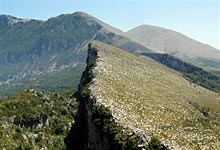
Maratea Mountains
The Italian region of Basilicata is located in southern Italy right between the toe (Calabria) and the heel (Puglia) of the “boot”. It has a section of coastline that looks out to the Ionean Sea and into the greater Mediterranean as well as a very small section of coastline along the Tyrrhenian Sea on the East coast of Italy. On this small eastern coastline, below the fashionable Amalfi Coast, lies the town of Maratea.
The town is divided into the small historic center which is nestled under a mountain uphill from the sea and the port of Maratea directly below on the sea. Aside from the old historic town center which is compact and easily walked, it is a moderately large town and fairly spread out within the low hills that are surrounded by larger mountains. The one supermarket is somewhat between the port and the historic town center (centro storico) but has most everything you would need that could not be located in the smaller specialty shops. The terrain is generally quite rugged as is the sea coast but nice beaches do exist and are easy to get to by car.
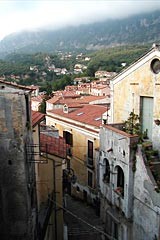
Old Town Center
Maratea is definitely not accustomed to a great deal of foreign tourism as mostly Italians vacation there. This can be seen in part by the port which is virtually new. Docked neatly around a few older fishing trawlers in the harbor were many luxury yachts and sailboats. I have it on reasonably good sources that these are not from local wealth. In fact the overall region of Basilicata is quite poor, largely agrarian and financially depressed. Walking the streets, we heard very little spoken besides Italian. Since my Italian is inept at best, this was a bit challenging. I had a hard time understanding my “base words” spoken in the local dialect and some people didn’t appear very interested in working with me on it. But persistence paid off as I ultimately found the local people to be friendly though perhaps a bit more aloof, or wary, than I was accustomed to in the northern regions in Italy.
Unlike some Italian destinations where having a car is either not permitted or just not useful, Maratea requires personal transportation with air conditioning! You can get there by train but having to walk everyplace in the heat of summer is very challenging. There are wonderful hiking opportunities but you need a car to get to them. We were there in early July and it was already very hot. Though we love to hike while vacationing, the typical day saw us preparing for a good walk … leaving the house we had rented in one direction, only to shortly return and head for the sea instead. But we soon adapted to what the climate gave us and found that driving up into the hills in early evening provided us with some memorable walks that included the unique sights and sounds of the Maratea countryside.
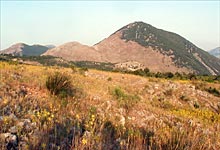
South of Maratea
The hills and mountains surrounding Maratea have an elusive quality. In the soft early evening lighting the terrain became restful, almost serene with its mixture of tans, grays, and greens. The gentle but very specific aromas of the vegetation fill the warm salty air as the bizarre melodies of bells on local herds of cows and horses drift down from the higher fields as the animals are brought back for the night. The bells that are traditional in this area are all different notes and the movement of a herd in the distance will often begin to sound like a particular song only to have one note run astray and randomness returns, soon to be followed by the start of yet another familiar tune.
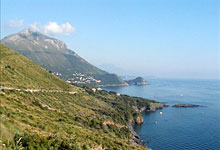
Maratea Coastline
But only a lunatic would rent an apartment on the coast of the sea to hike inland, right? The sea at Maratea is beautiful and extremely clean and the coastline is composed of some of the strangest rock formations imaginable, in may cases resembling imaginary worlds in the solar system. Caves and grottos are quite common along the coast though access to the water is not always easy. Once you start to putter along with a raft or flippers and a mask, you will easily lose track of time and burn the hell out of your back in the process!
Days in Maratea are easily spent jumping into the sea and exploring the amazing rocky terrain of the coast until lunch and then returning, maybe to a beach for a change, in the afternoon. Every beach we visited shared the interesting quality of having a cold fresh water stream running down from the mountains into the beach area. This made the sea near the shoreline a mixture of warm salt and cool fresh water. The streams were also very handy for cleaning off the salt and gravel from the beach. The beaches in this region are composed of water-worn pebbles, some containing fairly large stones up to near the water’s edge. A pair of water shoes can greatly enhance the fun of poking along the shoreline but are absolutely imperative for walking along the rocky coastline.
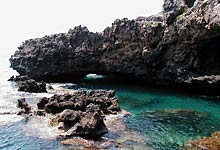
Sea Caves and Blue Pools
The salt from the sea is everyplace. The house we had rented was only 100 meters uphill from the sea. After four days, our bedroom and bedding began to feel like the inside of a submarine. The air was hot, humid and motionless. The sheets were so sticky from salt air that rolling over required a conscious effort … no sliding motion was possible. Italians do not believe in room fans or window screens and air conditioning is very uncommon. Thankfully I had anticipated this and brought a few small battery operated mini-fans. When the terrace doors from our bedroom to the patio had to be closed at night to keep out the many hungry insects, that still hot air quickly became suffocating to someone from a temperate climate.
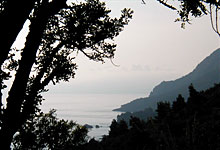
Twilight on the Coast
Yet, until actually going to bed, the balmy evenings enjoyed from our patio overlooking the sea were incredibly relaxing. The deafening sound of the Cicadas that cluster in groups of larger Carob trees softens in the dusk. Occasionally the small local fishing boats would concentrate in the area just offshore below our patio. The slow circular movement of the boats, each with a small light and softly chugging engine became mesmerizing. The result of the night’s harvest was available in town the next day along with other local specialties such as mozzarella and ricotta cheese.




